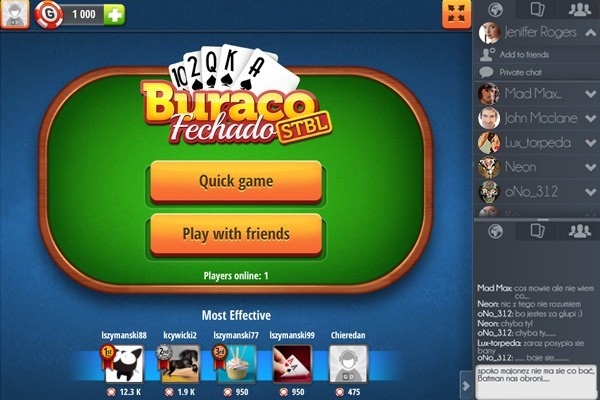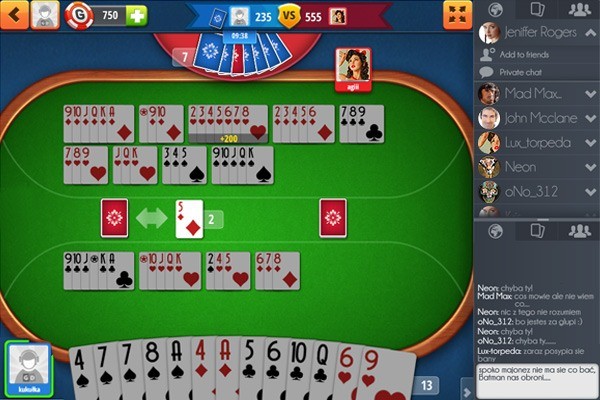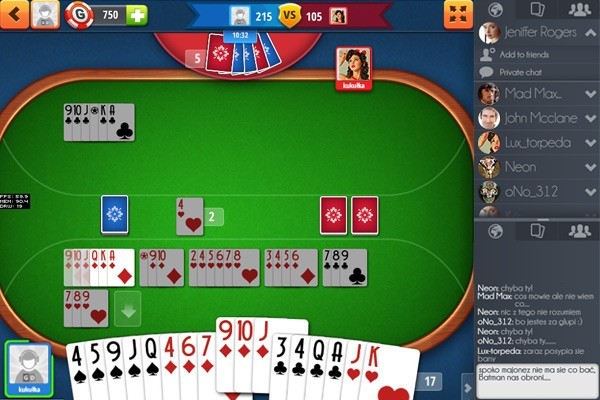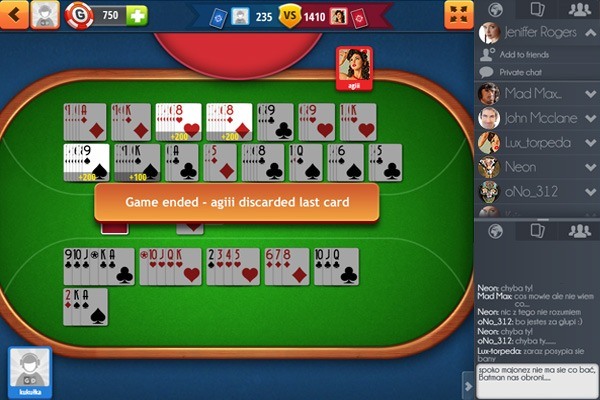How to play Buraco Fechado STBL - oyun kuralları
Buraco is a traditional card game, which comes from Uruguay and Argentina. It was invented in the 1940's. To this day, it is the most popular card game in South America, especially in Brazil. It is a rummy type card game, from the canasta family. It is worth mentioning that in Portuguese, "buraco" means "hole", which is associated with the feeling of sadness after failure. Buraco has several variants, the two basic types are Buraco Aberto (“open”), and Buraco Fechado (“closed”).
Buraco Fechado can be played with 2 or 4 players. With two players, the game is played "1 on 1", with four players, it's played "2 on 2". When playing with 4 players, each pair puts their points together. The game is played with 2 decks of cards, with two jokers in each. There are a total of 108 cards.
Object of the game
The object of the game is to have the highest score possible and to get rid of all your cards. You don’t win simply by discarding all 11 cards, like in classic rummy, because after that, you must take another 11 cards from the dead pile. When a player has gotten rid of their cards, the game is over. However, the winner is the player who has the most points, not necessarily the one who got rid of their cards first. The main components of the game involve melding and discarding.
Scoring
For every card melded, the player receive points. Additional points can be attained by melding special sequences (canastas). Negative points are also a possibility during the game.
Positive points are awarded for:
- melding the last card and finishing the game (100 points)
- melding cards, sequences and canastas:
- 2 (10 points)
- Joker (50 points)
- Ace (15 points)
- K, Q, J, 10, 9, 8 (10 points)
- 7, 6, 5, 4, 3 (5 points)
- dirty (mixed) canasta (100 points)
- clean canasta (200 points)
- 500 canasta (500 points)
- real canasta (1000 points)
Negative points can be received for:
- cards remaining in a player's hand at the end of the game
- a player, (or one of the players when playing "2 on 2") not collecting from the dead pile before the end of the game (-100 points).
Sequences
Sequences are sets of at least 3 cards of the same suit, which players meld, for example: J ♥, 10♥, 9♥.
Canastas
In the game there are canastas – sequences composed of at least 7 cards of the same suit, in consecutive order. They give the player extra points. Melding canastas properly has a significant impact on the final score.
Players can meld several variants of canastas, as follows:
- clean canasta (without wild cards)
- dirty (mixed) canasta (with wild cards)
- 500 canasta (from Ace to King – A, 2, 3, 4... K – without wild cards) – cards must be melded in one move
- real canasta (from Ace to Ace – A, 2, 3, 4... A – without wild cards) – cards must be melded in one move
Wild cards (2, joker)
- In the game, there are special cards, called "wild cards", that can replace any other card. These are: "Jokers" and "2s". A sequence or canasta with a "wild card" is called "dirty" or "mixed". A player receives less points for "dirty" canastas than for "clean" canastas.
- Both "Jokers" and "2s" can be put wherever needed in a sequence or canasta. For example, when the sequence: J♠, 2♥, K♠ is melded, we can add to it the Q♠ in next rounds. After adding the card, the sequence would look like this: 2♥, J♠, Q♠, K♠. (2♥replaces the 10♠). The same rule applies to the joker.
- "2s" can also be just normal cards. It means that if we use a "2", (first as a wild card) in the same suit as the rest of the cards in a sequence, it can become a "clean" sequence. (Also, "dirty" canasta can become "clean" canasta). For example, if we add the 4♠ to the sequence: 3♠, 2♠, 5♠, the "2" can be moved to the beginning and the sequence will look as it follows: 2♠, 3♠, 4♠, 5♠.
To begin
- In the beginning, each player receives 11 cards. Two dead piles are formed with 11 cards each. Each dead pile is assigned to one player (in "1 on 1"), or to one team (in "2 on 2" ). Other cards form a stock pile.
- First, the starting player draws one card from the stock pile. Now the player can meld cards if it is possible to form sequences with them. If not, (or if the player does not want to do it now) he discards one card to the discard pile (called „trash”). Discarding a card ends the round.
- In "1 on 1", each player has his/her own melds and is adding cards only to them. In "2 on 2" partners play together – they can add cards to those melded by their partner.
Gameplay
- During the next rounds, the players draw cards from the stock pile or from the discard pile („trash”). The rules for drawing cards from the discard pile are listed below. After drawing, the players meld sequences and add cards to those already melded or simply discard one card. They need to think about the best way possible to meld cards – to get the highest score.
- After discarding all 11 cards from his/her hand, he/she receives another 11 cards from the dead pile. Now, if the player can get rid of them, the game is finished. To discard the last card, the players need to have at least one "clean" canasta.
The discard pile ("trash")
The main difference between "Buraco Aberto" and "Buraco Fechado STBL" is the „trash”. The rules are as follows:
- It is forbidden to take only one card from the discard pile – if a player decides to take a card from this pile, they have to take all the cards from there
- Only the last card is visible in the „trash” (if the player remembers what is underneath, they have an advantage)
- When taking cards from the discard pile, the player has to use the first card immediately
- Only after using the first card can the player receive other cards from the discard pile
- If the first card is a "wild" card ("Joker" or "2"), the player has to form a new sequence with it (if he can't do that, he can't draw from the discard pile)
- Players know how many cards are in the discard pile as it can be seen beside the pile
The end
The game is finished if one of the following situations happen:
- A player (or team) gets rid of all their cards, the dead pile was drawn from, and the "clean" canasta were melded
- All cards from the stock pile and dead piles were used
At the end of the game the player, who threw away the last card, gets 100 points. Their opponent gets negative points for every card left in their hand – in accordance with the values described above. The winner is the player (or the team) with the highest score.




